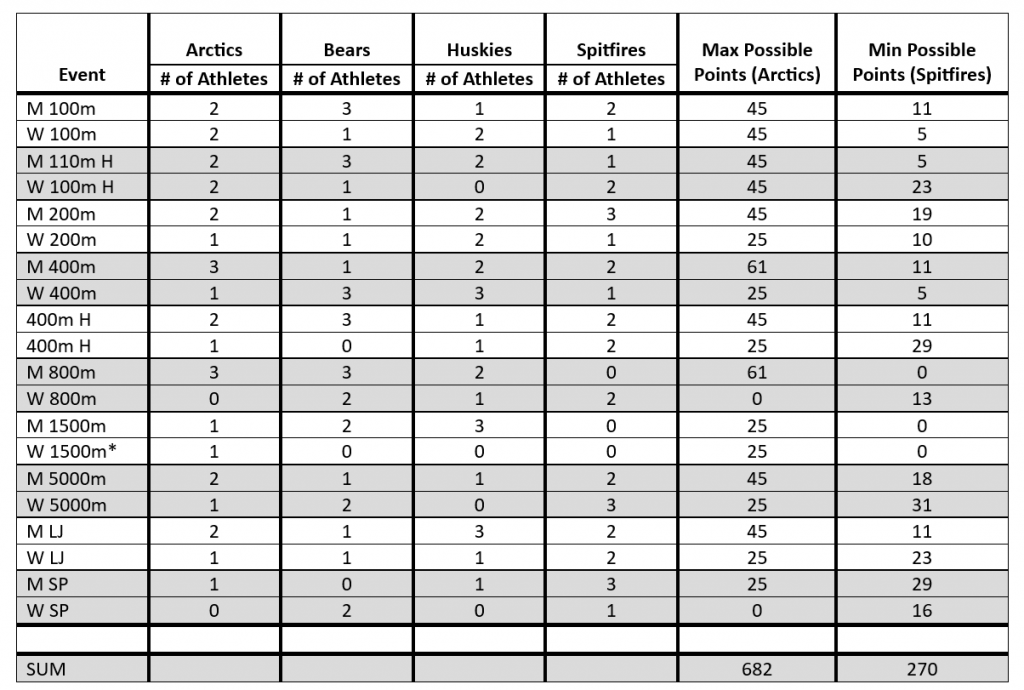For more writing on the CTFL, see our previous article: “For the CTFL to Fulfill Its Goals, The Athletes Have to Make It Happen.”
We’re nearing the completion of the second CTFL season here and the Spitfires are killing it. Partly because they share a name with the best OHL team that league has to offer (Go Spits), but mostly because their women’s contingent has gone new road mode and steamrolled the rest of the competition. That’s not all though, their men’s and utility athlete squads are also leading the table. They have all the chips and keep dipping them in spicy hot salsa that none of the other teams can handle. Yeah, it’s not easy to keep up with Spitfires athletes. It’s also sometimes not easy to keep up with Not Trackie predictions columns. If you picked up on us going from leading tables -> most chips at a casino table (and therefore leading it) -> chips and salsa, good job. Your brain is just as wack as ours.
ANYWAY, what we’re gonna do here is try to summarize how the CTFL works in as few words as possible and then check to see if it’s mathematically possible for a team to beat the Spitfires. For individual event breakdowns you can check out Nkele Martin’s analysis (here and here).
HOW IT WORKS
- Team Structure
- Scoring
- Prizes
1. Team Structure
CTFL athletes are grouped into “Core Athletes” and “Utility Athletes.”
- Core Athletes:
- Must compete in at least one preliminary CTFL meet plus the final if they qualify.
- Compete in one of the ten CTFL events.
- Only compete against CTFL athletes in their event.
- Are scored based on their times (track events) or measurements (field events) during the CTFL season.
- Utility Athletes
- Compete at any sanctioned meet.
- Choose one event that they will use for CTFL scoring.
- Compete against all utility athletes in all events.
- Are scored based on the World Athletics points equivalent of their results during the CTFL season.
After athletes registered and teams were selected in 2023 it looked like this:

Scoring
2.1. Scoring -Core Athletes
Core Athletes accumulate three scores during the season. A “Free Mark” score, “Preliminary Mark” score, and a “Championship Mark” score. These scores must come from three distinct performances (i.e. the preliminary mark cannot be used for the free mark too):
- Free Mark: A result that can occur at any sanctioned meet during the season
- August 2 was the free mark cutoff date
- Preliminary Mark: A result that occurs at an official CTFL meet during the season
- Championship Mark: A result that occurs at the CTFL Championship
- Only 8 athletes qualify for the championship, so some will score 0 points here
- Championship athletes were selected based on rankings as of July 17 (to give athletes time to adjust their schedule if they qualified)
An athlete’s best result for each of the three scenarios is recorded and then ranked against the other athletes in their event. They are scored based on the following points table.

So, if an athlete has the best free mark, best preliminary mark, and best championship mark, they score 75 points for their team for their event. Nice.
Note that there are 10 events with men’s and women’s divisions, so there are 20 different core athlete scoring tables. There is only one Utility Athlete scoring table.
2.2. Scoring -Utility Athletes
- Their top 3 results (up to August 2) are converted to World Athletics Points (see official tables here) and then added together.
- Bonus points are added (30 points per CTFL meet attended).
- The athletes are ranked in order of largest to smallest points sum
- i.e. The utility athlete with the largest sum of World Athletics Points + Bonus Points is ranked first, the utility athlete with the second largest sum of World Athletics Points + Bonus Points is ranked second, and so on.
- The utility athletes score the corresponding number of points based on their CTFL ranking as outlined below.

2.3. Scoring -Bonus Points
- Core Athletes who attend more than 1 CTFL preliminary meet during the season earn 1 bonus point per extra meet.
- Utility Athletes, as we already mentioned, earn 30 bonus points per CTFL preliminary meet attended.
2.4. Scoring -Team Total
- Add up the scores for each athlete and that’s the team total.
3. Prizes
The winning team at the end of the season receives $1,000 split evenly amongst its members. There are also prizes for individual athletes.
For Core Athletes, the prizes are given out in each of the 20 events based on the rankings at the end of the season (20 x $700 = $14,000).
- 1st: $400
- 2nd: $200
- 3rd: $100
For Utility Athletes, the prizes are given out based on the Utility Athlete rankings at the end of the season ($825 total).
- 1st: $250
- 2nd: $200
- 3rd: $150
- 4th: $100
- 5th: $75
- 6th: $50
If core athletes do not obtain at least one free mark, one preliminary mark, and one championship mark (if they qualify) they are not eligible for team prize winnings and only receive 50% of the winnings if they ended up in the top 3 somehow.
Can anyone beat the Spits?
Can anyone actually catch the Spitfires? After we narrow down the fields to the top 8 and remove athletes that have scratched, let’s take a quick look at the composition of the fields for the championship meet by team:

The Arctics are currently down by 251 points, so YES, if they have an absolutely insane day and the Spitfires are more Spit than Fire, the Arctics could win. *Insert “so you’re saying there’s a chance” meme.* Anyway, for the individual predictions you can check out Nkele Martin’s longer breakdown on the CTFL website, see here (distance and field events) and here (sprints).

